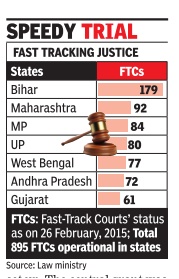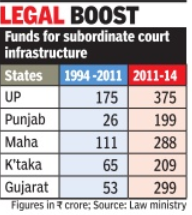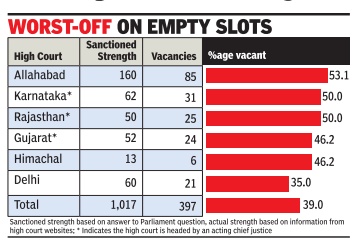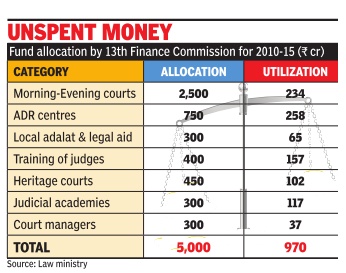Judiciary: India

This is a collection of articles archived for the excellence of their content. Readers will be able to edit existing articles and post new articles directly |
All India Judicial Service:rejected by High Courts
Feb 05 2015
TURF WAR - HCs reject proposal on All-India Judicial Service
The government’s proposal to form an All India Judicial Service for recruitment of judicial officers in the lower courts on the lines of civil services has been rejected by many of the high courts. At an advisory council meeting held by the law ministry recently, law minister Sadanand Gowda informed that “most of the high courts have not favoured the proposal”.
The law ministry had prepared a comprehensive proposal for the All India Judicial Service (AIJS) and the committee of secretaries approved the same in November 2012. Later, at the chief ministers and chief justices conference in April 2013, the higher judiciary sought more time for further deliberations.
The advisory council meeting was held on January 21 with the law minister on the chair. Those who attended included minister of state for home Kiren Rijiju, law commission chairman Justice A P Shah, the attorney general, chairman of the bar council and senior ministry officials.
Unless the high courts and states agree to the constitution of AIJS, the Centre cannot impose the judicial service on states. “The administrative control over the members of subordinate judiciary vests with the HC concerned,” a senior law ministry official said.
Also it is for the state governments to frame rules and regulations, in consultation with the high courts. Already most of the states have framed state judicial services rules governing service conditions of their judicial officers.
It had found favour with the Parliamentary standing committee which in its report in February last year had asked the government to fast track creation of AIJS without any further delay so that the judiciary gets the best talent available.
Difference in signature can invite penal action: Delhi HC
Abhinav Garg TNN
The Times of India, Sep 21, 2011
In an important ruling, Delhi high court has held that difference in the drawer’s signature can also invite penal action and a magistrate can take cognizance of a complaint highlighting the offence. Justice Pradeep Nandrajog said if the receiver of the cheque decides to initiate criminal proceedings against the drawer, the latter has to prove his innocence in court — that the difference in signature was a genuine mistake, not a deliberate one, done to prolong the actual payment of money.
“Prima facie, an offence of cheating would also be made out and the magistrate can even take cognizance of the same,” Justice Nandrajog noted while rejecting the plea of one Santosh Gupta. Gupta rushed to HC challenging the decision of the magistrate to summon him for the cheque dishonour case slapped by Religare Securities. Religare informed HC that Gupta owed them money. But when two cheques of Rs 5 lakh each issued by him were presented before the bank they were returned with the remark “drawer’s signature different” and “funds insufficient”. That’s when the company slapped complaints against Gupta before a magistrate.
Gupta blamed the company for presenting the cheque for clearance, claiming he had asked them to return the cheques so that he can issue a fresh one. HC rejected these contentions, imposing a punitive fine of Rs 25,000 on Gupta.
District judges, the selection of
From the archives of The Times of India 2010
Dist judges’ merit quota down 15%
Most Posts To Be Filled On Seniority
Dhananjay Mahapatra | TNN
New Delhi: The merit-based selection window to fill posts of district judges, who are key to the functioning and efficiency of the lower judiciary, will shrink by a huge 15% margin from 2011, the Supreme Court ordered on Tuesday. The large number of vacancies in the posts of district judges, who head the functioning of subordinate courts in the concerned district subordinate judiciary, weighed on the mind of the apex court and it ordered that the merit quota be reduced from 25% to 10% from January 1, 2011.
In 2002, the SC had ordered that of the total vacancies in district judges posts, 50% would be filled by senioritycum-merit from among the senior civil judges while another 25% would be filled by a limited departmental competitive examination to fasttrack promotion for the meritorious among senior civil judges. The rest 25% were filled through direct recruitment from the Bar.
But, the large number of vacancies — in some states more than 50 accumulated over the years under the 25% competition examination quota —made a Bench comprising Chief Justice K G Balakrishnan and Justices Deepak Verma and B S Chauhan to wear their thinking caps. On one hand, amicus curiae and senior advocate Vijay Hansaria reeled out statistics about the large number of vacancies in the posts of district judges and the mounting pendency of cases, while on the other major high courts — Bombay, Gujarat, Madhya Pradesh, Rajasthan and Orissa — opposed any reduction in the 25% merit-quota in recruitment.
Even those states where the HCs were opposed to reduction in the merit quota, there were a large number of vacancies in district judges posts. However, the court did not interfere with the ongoing process for selection of district judges under the 25% quota. But, what it ordered was that from January 2011, the quota would be reduced from 25% to 10% and if still posts remained vacant, they would be filled through regular promotions.
This means, the quota for selecting district judges through regular promotion would now swell from 50% to 65% of the total vacancy.
Appeals: HCs overturn90% of trial court orders
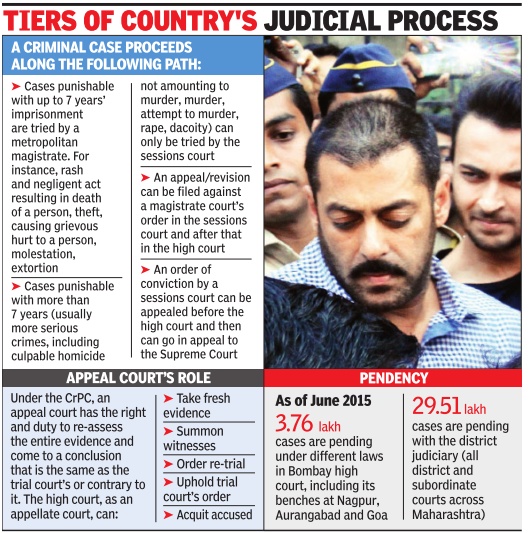
The Times of India, Dec 13 2015
Trial court orders are overturned by high court in 90% of cases: Lawyers
Swati Deshpande
`There's Nothing Singular About Salman Verdict' Actor Salman Khan, ac quitted by the HC of all charges in the 2002 Bandra hit-and-run case, is not an exception. He is among thousands of accused who are convicted by a lower court, only to be acquitted by a high court.HC orders often cite poor police investigation of a crime and faulty appreciation of evidence by the trial judge as reasons for setting aside guilty verdicts. While data on trial court convictions turning to acquittals is not compiled by the judiciary , a defence lawyer said that from 2013 till June 2015, out of 70 appeals in which he appeared in HC in Mumbai alone, he got acquittals in about 90% of the cases. Several lawyers cited such informal statistics. One of them said acquittals are not unusual in a HC-the last court on facts in a criminal case.
“Reasons given for the acquittals are mostly on the probability based on fact and circumstances of the case and on legal aspects that are usual on the point of appreciation of evidence by the lower court and thus admissibility of the evidence,“ said senior advocate Niteen Pradhan. “Most of the acquittals are due to the ineptness and inability of the police to perform their duty professionally , which is sometimes also a result of political interference.
“A glaring example was the Radhabai chawl incident, which sparked the 1993 riots.The Tada court had convicted over a dozen accused. But the SC in early 2000 acquitted all, disbelieving their confessions recorded by the police. The findings of the SC reflected poorly on police. Does it mean that no one had torched five persons to death? Drastic improvement in investigation by the police and reduction of political interference is needed.“
Legal experts compare the movement of a case from the trial court to the SC to a multilayered filtration process, where each court fulfils its responsibility; a trial court decision if overturned later by an appeal court can still get restored when the appeal court verdict is challenged before a superior court. The purpose of judicial hierarchy is to ensure that justice gets done, through checks and balances.Some feel that a decision by a subordinate criminal trial court is made sometimes with the knowledge that there are several layers ahead where there will be greater scrutiny.
Advocate Ayaz Khan, who appears in drug cases, said, “Sometimes there are cases where the trial court does not consider several factual aspects or even legal aspects slip their mind. Therefore the accused succeed in the HC.“ He agreed that a large number of cases end in acquittal. He appeared for a convict in a narcotics case which resulted in an acquittal before Justice A R Joshi late last month.
Another lawyer, Sujay Kantawalla, who appears in cases of customs-related offences, said that not all convictions end in acquittals. “Sessions court judges, despite lack of proper infrastructure, still pass reasoned orders. It's not that all convictions get over turned. But rarely does a trial court acquittal turn into a conviction in the HC.“ Reversal of acquittal or conviction is no mystery if one sees how `proof ' is defined in the Evidence Act.Veteran criminal lawyer Shrikant Bhat said, “Proof is the belief created in the mind of the trial court judge by evidence.Such belief is subjective.“
Bhat said, “Mainly , the HC reassesses the evidence and decides the correctness of the conclusions of the trial court.It may find that evidence of particular witnesses was not reliable or was reliable, and can decide whether witnesses accepted as experts by a trial court are indeed experts as required under the Evidence Act. The HC can see if the law is correctly applied. In murder cases, half the time the HC either acquits or reduces the offence to a lesser offence.“
Just as the HC changes or reverses the judgment of a trial court, the SC does likewise with HC judgments.
Can the actor's driver be tried?
Can Salman Khan's driver Ashok Singh, who confessed at the last stage of the trial that he was behind the wheel of the actor's SUV when the 2002 accident occurred, be tried? Most experts answer in the negative. There cannot be reinvestigation in a criminal case on issues that have already been investigated. The only exception was the postGodhra Best Bakery case, when the Supreme Court directed reinvestigation. “The order was exceptional and can't be used as a precedent. Investigation once completed, can't proceed on reinvented facts,“ said advocate Niteen Pradhan.
The HC order gives a certain finality to the Salman case and although the state can appeal against the acquittal, it can challenge it only to secure Salman's conviction based on re-interpretation of the existing evidence. The prosecution has always maintained that Salman was driving the car and trashed Singh's version as “unbelievable and put up“ in trial court when Singh deposed as a defence witness.Singh was neither an accused in the case nor a prosecution witness against the actor, and now lawyers agree that he is unlikely to be made an accused after so many years.
Salman Khan, a day after his acquittal, withdrew from the SC his plea to make singer Kamaal Khan a witness. The actor had sought to challenge a Bombay HC order earlier in December 2015 rejecting his plea to make his UK-based singer friend Kamaal a court witness during the hearing of his appeal against his May 2015 trial court conviction.
Fast-Track Courts
Bihar tops in justice delivery with 179 fast-track courts
TIMES NEWS NETWORK The Times of India Mar 04 2015
Bihar continues to operate the highest number of fast-track courts in the country , with 179 of them functional as of last month. Maharashtra, Madhya Pradesh, UP, Bengal, Andhra Pradesh and Gujarat are others with high number of such courts. The Centre plans to encourage setting up of at least 1,800 fast-track courts (FTCs) to deal with cases of heinous crimes, cases involving senior citizens, women, children, disabled and disputes involving land acquisition and property pending for more than five years.
Besides, the government has also proposed setting up 460 family courts in the next five years in districts with a population of one million or more, where these courts are not already present. The funding of these projects will come through the 14th Finance Commission awards.
Earlier, in 2000, the central government had allocated financial resources to the states for setting up fast-track courts when 1,734 FTCs were set up. The central grant was made available for a fixed time period of five years but was extended till 2011. Some of the states such as Bihar, Himachal and Maharashtra have continued FTCs with their own resources.
However, during a recent meeting of the advisory council of the National Mission for Justice Delivery and Legal Reforms, chaired by law minister Sadananda Gowda in January, an opinion was expressed against encouraging FTCs. A view was expressed that fast tracking certain categories of cases results in slow tracking other categories.Law commission chairman Justice A P Shah had suggested that a more holistic approach be adopted for pendency reduction.
After the Nirbhaya gangrape incident of December 2012 in Delhi, the law ministry had decided to provide funds up to Rs 80 crore per annum on a matching basis from states till March 2015.However, the Centre specified that this grant money will be used only for the purpose of meeting salaries of judges required for running these FTCs.
After the Delhi incident, states and chief justices had resolved to set up additional FTCs relating to offences against women, children differently abled persons and senior citizens and marginalized sections of society.
According to a status report of the law ministry , 212 FTCs have been set up so far for the purpose of fast tracking cases against women and children in 16 states.
Fast track courts: 2000, 2015
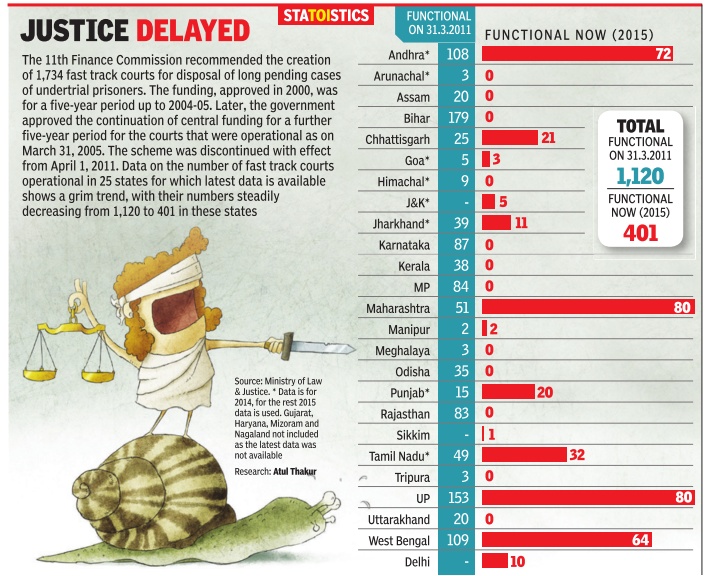
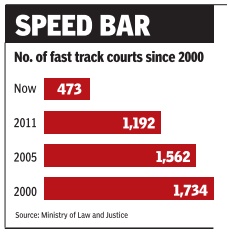
Subordinate Judiciary
"Lower" courts
From the archives of The Times of India 2010
Crisis of merit in lower judiciary
Not Enough Qualifying In Competitive Test For District Judge Posts, SC Told
Dhananjay Mahapatra | TNN
Judiciary faces a crisis of merit at a crucial layer as majority of the states are finding it difficult to fill 25% of district judge posts through a limited departmental examination that was devised to give talent a speedy promotion route.
This became clear before the Supreme Court as senior advocate Vijay Hansaria as amicus curiae pointed to the large number of vacancies in district judge posts, which is the highest level in the lower judiciary responsible for fighting the huge pendency of nearly 2.6 crore cases.
The large number of posts falling under the cadre of Higher Judicial Service was mainly vacant due to failure of existing judicial officers to clear the tough departmental competitive test. The situation is so bad that in Tripura, eight posts were advertised under the speedy promotional route but only two candidates applied, Hansaria said.
Taking up an application filed by Rajasthan Judicial Service Officers’ Association through counsel A D N Rao, a bench comprising Chief Justice K G Balakrishnan and Justices Deepak Verma and B S Chauhan said this was the situation in almost all states.
Rao gave a chart of the vacancies under 25% quota for speedy promotion through competitive examination. It said West Bengal had 50 vacancies, Uttar Pradesh 24, Maharashtra 42 and Orissa 12. The apex court had noticed on January 13 that in Bihar, though 16 posts were available, the HC could fill only two.
The bench issued notice to high courts for their response to the proposal — fill the existing vacancies through promotion based on seniority and reduce the competitive examination quota from 25% to 5%.
At present, 50% of posts of district judge are filled through promotion, 25% through direct recruitment from lawyers and 25% through limited departmental examination. Though the bench felt 25% posts through departmental examination could be filled through an all-India competitive examination, it veered around to the idea of reducing the quota.
The HCs have been asked to send their responses to the apex court before April 20, when the matter will be taken up for hearing afresh.
LOWERING THE BAR?
States finding it difficult to fill 25% of district judge posts through limited examination meant to give talent a speedy promotion route Bengal had 50 vacancies, UP 24, Maharashtra 42 and Orissa 12
SC bench issued notice to HCs for their response to proposal to fill existing vacancies through promotion based on seniority and reduce competitive exam quota from 25% to 5% At present, 50% district judge posts filled through promotion, 25% through direct recruitment & 25% through exam
Disposal of cases in September 2015
The Times of India, October 8, 2015
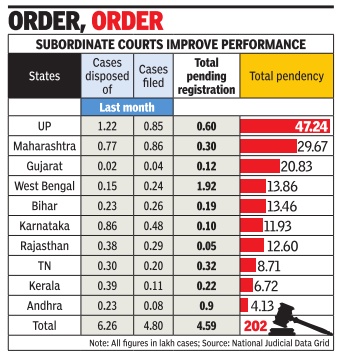
Pradeep Thakur
UP courts dispose of record 1.2L cases in Sept
The subordinate judiciary is showing some impressive results. The state with the reputation of being a laggard, Uttar Pradesh, has beaten courts in other states hands down in disposing of cases. The state with the highest number of pendency has disposed of more than 1.22 lakh cases last month alone. This was also probably one of UP's best performances given the fact that only 84,000 new cases were filed that month. Nationally , a little over 15,000 courts have disposed of 6.26 lakh cases last month as against 4.80 lakh new ones registered.
West Bengal remains among the worst performers with more than 1.92 lakh cases waiting to be registered and where courts have not yet provided a date to the litigants.Last month it disposed of around 15,000 cases as against 23,000 new cases filed.
In the case of UP, cases pending for registration is also much lower (60,000) than West Bengal which is a matter of concern for the Calcutta high court and also the state government which needs to aggressively push judicial reforms and expansion of courts in the state.
Information for subordinate courts in Delhi and Madhya Pradesh were not availa ble as the two states are yet to join the National Judicial Data Grid (NJDG).
As of now, the NJDG's public access page gives consolidated figures of pendency of cases in district judiciary across India. There is, however, no specific information on adjournments in each case, life cycle of a case before its disposal and whether first-cum-first-serve basis was applied in determining the trial of a case. Presently, the judicial data grid has information on only 2 crore pending cases as against pendency of more than 3.10 crore cases.
Like UP , the subordinate judiciary in Karnataka, Kerala, Tamil Nadu (TN), Rajasthan and Andhra Pradesh has shown better performance in terms of more disposal of cases than registered every month.While in Karnataka more than 86,000 cases were disposed of last month against 48,000 filed, in Kerala over 39,000 cases were disposed of against 11,000 filed.
In Andhra Pradesh, only 8,000 new cases were filed last month against 23,000 that were disposed of. The state has managed to bring down the total pendency of cases to almost 4 lakh though more than 90,000 cases were pending for registration, a parameter which indicates the state judiciary needs to introduce more transparency in court processes.
The government is also considering to get an independent study conducted on the data now available through the NJDG to find out the cause of huge pendency of cases.
2014: 3.07 crore cases pending, 2 crore over 5 years old
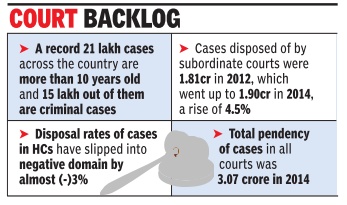
The Times of India, Oct 12 2015
28% of Rs 2cr pending cases over 5 yrs old
66% of prison population is of undertrials
The attempt to initiate transparency in justice delivery has failed to bring cheer to poor litigants. More than 28% of the 2 crore case pending in subordinate courts are over five years old, shows the latest statistics of the National Judicial Data Grid. It's not surprising that of the total pendency , a record 21 lakh cases across the country are more than 10 years old, and 15 lakh out of them are criminal cases where many undertrials remained behind bars even before their cases came up for trial.
The Supreme Court monitored e-courts project has brought in several changes in the justice delivery system. Most of the 15,000 courts in the country have been computerised and connected to the NJDG. A daily update on cases is reflected on the grid which is now open to public. Though the performance of 24 HCs are not reflected on the NJDG, in response to a Parliament question, law minister Sadananda Gowda had given out some statistics that showed a dismal performance. The disposal rates of cases in HCs have slipped into negative domain by almost (-)3% -from 17,86,170 cases disposed of in 2012 to 17,34,542 in 2014.
The performance of district and subordinate courts have been still better than the HCs. Cases disposed of by subordinate courts were 1,81,97,153 in 2012, which went up to 1,90,19,658 in 2014, an increase of 4.5%.
However, the better performances of apex court and the subordinate courts did not result in any major reduction in pendency . The total pendency of cases in all courts was 3.13 crore two years ago, which remained at 3.07 crore in 2014. The reduction was a little over six lakh cases during this period.
The conditions of undertrials have not improved either. Over 66% of the nearly 4 lakh prison population is of undertrials, a majority of them booked for petty offences and who cannot afford a lawyer and obtain a bail leading to years of incarceration.This despite the fact that the apex court had in a judgment on September 5 last year set a deadline of two months (by December 1, 2014) to release all undertrial prisoners who qualified as per its order.
Unique IDs to track work of 17,000 judges/ 2016
Pradeep Thakur, Unique IDs to track work of 17k judges, Nov 07 2016 : The Times of India
The government has issued unique identification numbers to 16,795 judges of district and subordinate courts across the country for better monitoring of their judicial functions. Supreme Court and high court judges have been exempted from the exercise.
As part of ongoing judicial reforms and modernisation of courts, digital signatures have also been provided to most judges in the district and subordinate judiciary so that they can sign orders while delivering the judgment, which can then be uploaded in real time. Judicial officers have been given laptops, printers and internet connections to facilitate the task.
Modernisation of courts is being carried out by the government as part of the eCourts project monitored by the apex court. The first phase of the project was completed in March 2015. The second phase is under way and will include giving unique IDs to the remaining 2,482 judges of district and subordinate courts and extending video-conferencing facilities to all courts.
TOI had reported on October 10 and 13 on the drive to allocate unique IDs to judges.The government had said the decision was part of a policy prepared under the guidance of the judge-in-charge of the eCommittee of the SC.
The idea behind giving unique IDs is to bring more transparency in judicial functions by making available all judgments delivered by a jud ge during hisher career on the publicly-accessible National Judicial Data Grid. The measure will help in effective tracking of judicial work.
The National Informatics Centre (NIC) is currently rolling out the upgraded software, the case information system (CIS) 2.0 version, for the eCourts project.
New additional fields in the system would make it mandatory for a judge to record the nature of daily proceedings, such as whether the hearing was for recording of witness statement, process evidence, arguments or if the case was adjourned.
Vacancies in courts not filled; shortage of judges
Judge-population ratio
The Times of India, Apr 17 2016
India has 17 judges for a million people
Pradeep Thakur
A 1987 report of the law commission had drawn a blueprint of the manpower required in the judiciary. At that time, the strength of the judiciary was 7,675 judges, or 10.5 judges per million people. The judge-population ratio (sanctioned strength) has since increased to 17 judges per million but the vacancies have surpassed the 5,000 mark and so have the backlogs.
The current sanctioned strength of the subordinate judiciary is 20,214 judges while that of the 24 high courts is 1,056 and the pendency of cases has remained abnormally high at 3.10 crore. On the sanctioned strength, there are 4,600 vacancies of judges in the subordinate judiciary which is more than 23% of the strength. The situation in the high courts is worse with almost 44% (462) judges' posts vacant. The Supreme Court too has six vacancies on a sanctioned strength of 31.
The appointments have been held up following a standoff between the apex court collegium and the government over the finalisation of the memorandum of procedure for selection of judges.
To address backlogs in justice delivery , the 120th report of the law panel had proposed to increase the strength to 50 judges per million people -less than the US where the judge-population ratio then was 107. In case of UK it was 51, for Canada it was 75 and Australia 42.
The 50 judges-per-million view was supported by the commission in its 245th report submitted to the government in 2014, an exercise carried out after three decades of the first manpower assessment without any substantial follow up action. The 20th law commission study found at the current rate of disposal, HCs require an additional 56 judges to break even and an additional 942 judges to clear the backlog. This estimation was based on the sanctioned strength of the HCs at 895.
“Bihar, for example, requires an additional 1,624 judges to clear backlog in three years,“ the 20th law panel observed. The problem of backlogs is compounded by the fact that in some states courts are unable to keep pace with new filings. As data shows, even where the courts are breaking even, the system is severely backlogged and requires urgent intervention.
Given the large number of judges required to clear pendency and the time to complete selection and training processes, the law commission recommended that the recruitment of new judges should focus, as a matter of priority , on the number of judges required to break even, and to dispose of the backlog in a three-year time frame.
Simplification of court procedures is another problem area. Different HCs have different procedures and rules. There is no uniformity , despite the fact that the government has repeatedly written to the chief justices to develop common court procedures.
Shortages of judges, courtrooms stifles justice delivery/ 1994-2014
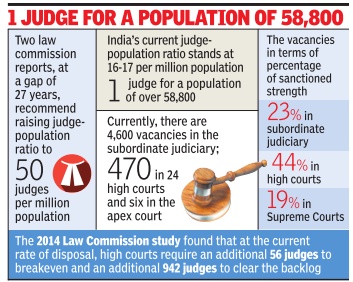
Pradeep.Thakur@timesgroup.com New Delhi:
The Times of India Jul 30 2014
Justice delivery has been hamstrung under successive governments for want of resources to provide enough courtrooms to accommodate the existing sanctioned strength of judges in high courts and subordinate judiciary .
An assessment by the law ministry in 2011 on funds requirement for infrastructure development in the subordinate courts had pegged it at Rs 7,346 crore for a period between 2011 and 2016. Against this, only Rs 2,200 crore has been released till March 2014.
The issue of lack of funds for new courts was recently raised by Chief Justice of India R M Lodha who sought additional allocation for the judiciary to fill up vacancies. There are at least 270 vacancies of judges across 24 high courts in the country. Situation is worse in the subordinate judiciary where there are more than 4,300 vacancies. The Narendra Modi government too has allocated a paltry Rs 1,100 crore in 201415 against the government's total plan expenditure of Rs 5.75 lakh crore. Out of the plan outlay of department of justice, only Rs 94 crore has been earmarked for justice delivery and Rs 936 crore for infrastructure development.
A review of existing infrastructure at some of the high courts revealed that even the projected new courtrooms in the next few years were not sufficient to accommodate the existing sanctioned strength in many of them.
HCs: 2015, Vacancies HCs
The Times of India, Oct 18 2015
Shankar Raghuraman
HC vacancies hit 39% amid executive-judiciary face-off
The stand-off between the judiciary and the executive on how to appoint judges comes at a time when the country's 24 high courts have 397 vacancies for judges; what's more, eight HCs have acting chief justices. It is not clear at this point whether these vacancies can now be filled through the earlier collegium system or will have to wait till the system is improved as the Supreme Court has said it should be.
Data collated from HC websites shows that as of now, 397 of 1,017 posts of justices of high courts are vacant. That's a vacancy level of 39%, a serious shortfall when lakhs of cases are pending in the courts.
The biggest shortfall in absolute numbers and propor tion of sanctioned posts is in Allahabad where there are 75 judges against a sanctioned strength of 160.
50% Raj posts vacant, That means the num ber of vacancies, 85, is more than the number of sitting judges.
The Karnataka and Rajasthan high courts also have half the sanctioned posts lying vacant.
Another seven high courts have vacancy levels of over 40%. These include Gujarat, Andhra Pradesh and Madhya Pradesh. The Bombay high court with 33 vacancies, the Punjab & Haryana high court with the same number and the Madras high court with 23 vacancies are not significantly better off. These are among the biggest high courts in the country handling the largest workloads.Vacancies in them, therefore, have a serious impact on disposal of cases in the higher judiciary .
In fact, only three of the high courts are operating at full strength at the moment and these are the high courts of Sikkim, Meghalaya and Tripura. However, these are all much smaller high courts with sanctioned strengths of 3-4 judges.
The information collected from the websites also shows that the Bombay , Andhra Pradesh, Gujarat, Karnataka, Patna, Punjab & Haryana, Rajasthan and Gauhati high courts are all functioning with acting chief justices at the moment.
Will the confusion on what happens to appointments in the higher judiciary mean the situation not only continues to remain bad, but could actually worsen with some judges retiring? Don't bet against that.
HCs: Rift with government, unfilled vacancies/ 2015
The Times of India, Jun 01 2015
A subramani
33% of Madras HC judicial seats lying empty
It is a constitutional vacuum few are interested in resolving at the earliest, except, perhaps, the legal fraternity . At least 125 names, shortlisted and recommended by collegiums of various high courts in the country , for appointment as judges, are stuck even as the Centre is involved in a bitter legal battle with the higher judiciary over the National Judicial Appointments Commission's constitutionality, composition and powers.
As on date, no fresh appointments or even transfers of judges in higher judiciary are possible since the collegium system has been disbanded and the proposed NJAC is nowhere near reality . “For instance, onethird of the 60-member Madras high court is vacant and there is need for a few transfers as well. But though the court had forwarded nine names for appointment as judges more than four months ago, there has been no whisper from the Centre or SC,“ a top jurist told TOI.
The vacancy position in the HC plummeted below the one-third mark, with the retirement of senior judge Justice V Dhanapalan. In a fortnight another judge -Jus tice R S Ramanathan is set to retire. So, by mid-June, the court will have only 38 judges.Of them, Justice S Palanivelu, who has been ailing for more than a year now, is in no position to discharge his judicial work in a normal manner. Justice K B K Vasuki will retire in September, bringing the sitting strength to 37 by year-end.
“No exemptions or special approach to Madras high court is possible, as more than 100 names recommended for appointment as high court judges too are stuck,“ the jurist said.
Thanks to the revised norms wherein only the main cases are taken into account for both disposals and arrears, the Madras HC had 2.63 lakh pending cases on December 31, 2014.
Subordinate courts: 2015, almost ¼ posts vacant
Judicial vacancies in lower courts cross 5k, Oct 19 2016 : The Times of India
Delhi, Bihar And Gujarat Worst-Hit
It's not just the higher judiciary that is reeling under the pressure of huge vacancies and increasing burden of pendency of cases.A law ministry report says the situation in the subordinate courts is getting worse with the number of judges' posts vacant in the subordinate and district courts across the country crossing 5,000.
As of December 2015, the vacancies stand at 5,111 against a sanctioned strength of 21,303 judges in the subordinate judiciary. Gujarat, Bihar and Delhi rank among the states with the highest number of vacancies -about 40% to 44%.
In terms of numbers, the highest vacancy of judicial officers is in Gujarat at 794 against a sanctioned strength of 1,953, around 41% of its sanctioned strength. This is followed by Bihar with 792 against a sanctioned strength of 1,825, about 43% of its approved strength; UP has 595 posts to be filled, but they account for just 25% of its sanctioned strength of 2,394 judges. Lower courts in Delhi have 307 judges against a sanctioned strength of 793, which is around 39% of its approved strength.
Subordinate courts account for at least 2.30 crore of a total of about 3.15 crore pending cases across the country .UP alone accounts for 23% of these cases. In mid-2015, an estimation had put vacancies in lower courts at around 4,400.The rise in vacancies are a cause of concern for the Cent re since lower court judges are recruited through an examination conducted by state public service commissions or the respective high courts.
Even in the HCs, which have 464 judicial posts vacant against an approved strength of 1,079, the Centre merely plays the role of a post office, and in rare instances it refers back recommendations made by the Supreme Court collegium for reconsideration. To improve the efficiency of judges, the government is working closely with the SC in giving unique identification numbers to judges of the subordinate courts.
2016: Govt. disagrees that 40,000 judges more needed
The Times of India, May 26 2016
Amit Anand Choudhary
Centre rejects CJI's claim of need for 40K more judges
The Centre virtually rejected Chief Justice of India T S Thakur's claim that 40,000 more judges were needed to obliterate over three crore pending cases by saying that his estimates were not backed by any scientific research or data.
Referring to 1987 Law Commission report suggesting increase in judges' strength, the CJI had on May 8 said the judiciary needed an additional 40,000 Judges to erase the mounting pendency . Law minister V Sadananda Gowda, however, said the Commission's report was based just on the opinion of experts.
“Law Commission's report of 1987 was based on opinion of experts and general public. No scientific data is available till now, therefore we cannot say much about it,“ he said.
At present, India has 10.5 judges per million, one of the lowest in the world. The Law Commission had in 1987 recommended that there should be 40 judges per million population. In 2014, the Commission in its 245th report suggested that it should be 50 judges per million.At present, total sanctioned strength of judges is 21,598, including 20,502 trial court judges, 1,065 HC judges and 31 Supreme Court judges.
Presenting the performance report of his ministry during the two years of NDA government, the minister re futed the allegation that the Centre was delaying the appointment process and said names of four persons for appointment as judges of the SC was cleared within six days. He said the Centre was processing names of 170 judges for appointment in HCs and it would soon be cleared.
“Judges' sanctioned strength in HCs has been increased from 906 on June 1, 2014 to 1065. In the case of subordinate courts, the sanctioned strength has been increased from 17,715 at the end of 2012 to 20,502,“ he said.
2016: 24 HCs have 43% vacancies
Pradeep Thakur, 24 HCs have a total of 43% judicial vacancies, Nov 02 2016 : The Times of India
The justice delivery system is taking a beating. Andhra leads with 62% vacancy among the 10 high courts with most number of vacant judicial posts.
The approved strength of the country's 24 high courts is 1,079, of which 464 posts or 43% are vacant.
According to the law ministry , 10 HCs account for 355 of the 464 vacant posts as of October 1. Allahabad HC leads with 83 vacant posts of judges, accounting for 52% of its approved strength. It is followed by Punjab & Haryana HC with 39 va cancies, or 46% of its sanctioned strength. The high court of judicature at Hyderabad, formerly the Andhra Pradesh HC, has 38 vacancies which is 62% of its sanctioned strength of 61, Karnataka HC has 36 posts vacant or 58% of its strength of 62 judges.
Between June 2014, when the NDA government assumed office, and now, the combined approved strength of the 24 HCs increased from 906 to 1,079. The increase in sanctioned judicial posts by 173 judges has primarily been responsible for an overall vacancy of 43%. The government claimed the working strength of judges in HCs remained more or less at the 615620 level during this period. In 2014, the 24 HCs had 267 vacant positions against an approved strength of 906. The vacancies accounted for less than 30%. In contrast, as a percentage of the sanctioned strength, the vacancies have gone up to 43% as of October 1.
Transparency
Lack of transparency in judicial functioning
The Times of India, Jun 28 2015
Pradeep Thakur
Give report on Backlog Panel, CJs told
Govt seeks update on HC pendency pickle
To bring accountability and transparency in the judiciary's functioning, law minister Sadananda Gowda has written to the chief justices of all 24 high courts and sought reports on the status of the arrears committee each of the HCs was to set up to bring down case pendency. In April 2015, at the chief justices conference, all the CJs had pledged to set up an arrears committee in each high court to dispose of cases pending for over five years in their respective HCs and the subordinate courts under them.
The NDA government had earlier taken up the matter with the Supreme Court, and the Chief Justice of India wrote to HC chief justices to deal with pendency .
Lack of transparency in judicial functioning has led to a higher pendency rate for older cases. There are plenty of instances, in fact, in some courts and under certain judges where adjournments have been the norm rather than exception.
As of December 2014, there were over 23 lakh cases pending for over five years in high courts alone. Add to this the pendency in subordinate courts, and the figure is staggering. The law minister had recently informed Parliament that the pendency in subordinate courts was a matter of concern, with over 82 lakh civil and 1.83 crore criminal cases pending.
Gowda has asked the CJs to submit a report detailing the steps taken towards reduction in pendency , and number of cases older than five years disposed of. He has also sought to know which of the HCs had set up the arrears committee.
Special courts: funds not utilised
Mar 24 2015
80% of funds for special courts remain unutilized
Law Minister blames bar associations
The government has said that more than 80% of funds allocated in the last five years for setting up of special courts and training of judicial officers have remained unutilized as a result of resistance faced from bar associations in states. Law minister Sadananda Gowda, responding to a Parliament question last week, had cited non-availability of judges and geographical constraints as some of the other reasons for not meeting the target of spending the Rs 5,000 crore funds allocated as per the 13th finance commission grants.
Only Rs 970 crore, or less than 20% of the allocation, was spent for the purpose for which the grants were allocated for the period 2010-15.
The minister's response is at odds with the remarks made by the higher judiciary which has often expressed concern about non-availability of adequate funds. In his statement, Gowda said Rs 2,500 crore was sanc tioned for constituting special morning and evening courts. However, just Rs 234 crore out of that was utilized even though the government had released Rs 835 crore till February 2015.
The government had allocated Rs 700 crore for setting up of Lok Adalats and legal aid and towards training of judicial officers and public pros ecutors. However, under these heads, the total utilization from states so far has been not more than Rs 222 crore.
The low utilization of funds over the years has resulted in pendency of cases remaining high in courts across the country .
Gowda said utilization of funds for morning, evening and shift courts has been very low also due to non-availability of retired judicial officers for these courts. Even for the regular courts, there are huge vacancies.
Against a sanctioned strength of 984 judges in 24 HCs, there are only 636 judges at present. Almost 348 posts are vacant-highest being in the Allahabad HC which has 75 vacancies against a sanctioned strength of 160 judges.
The lack of manpower has resulted in large pendency. At last count, the pendency of cases in all courts was as high as 3.2 crore.
Trial courts: Two-shift system
From the archives of The Times of India 2010
SC: Two-shift trial court system Two-shift a failure, won’t cut pendency
Dhananjay Mahapatra | TNN
New Delhi: Four years after hitting upon the simple yet effective idea of operating trial courts in two shifts to tackle the 3 crore pendency in subordinate judiciary, the Supreme Court on Tuesday appeared sceptical about the experiment. A bench comprising CJI K G Balakrishnan and Justices Deepak Verma and B S Chauhan said the idea was implemented to dispose of petty cases and not to hold regular trials during the morning and evening shifts.
“It will be a little too much to ask the trial judge to come in the morning and hear cases till late in the evening,” the bench said and suggested that the only way out was to increase the number of judges, whose strength at present was woefully inadequate to tackle the backlog. This stand assumes significance as PM Manmohan Singh had said on Saturday that the backlog and delay in disposal of cases had diminished the inherent strength of the judiciary.
Amicus curiae C S Vaidyanathan agreed with the bench and said, “An amount of Rs 2,500 crore is being provided to facilitate setting up of morning and evening courts in all the 14,825 district and subordinate courts in the country. This is an impractical and unfeasible proposal. Only petty criminal or compoundable cases were intended to be disposed of in such morning/ evening courts.”
Recusal of judges
Feb 23, 2015
Seeking recusal of judges now a trend in high-profile cases
Dhananjay Mahapatra
Stepping into the Supreme Court premises for the first time as a student of law was an exhilarating experience. It literally gave goosebumps. We had read landmark judgments given by this great institution which kept ‘rule of law’ and ‘equality’ secure in the stormiest periods. Covering the Supreme Court on a day-to-day basis for the last two decades has been no less exhilarating. The court always gives a distinct impression that it strictly adheres, or as far as possible, to the maxim: “be you ever so high, the law is above you”.
These immortal words by 17th century English churchman and historian Thomas Fuller read, “Be ye ever so high, still the law is above you.” Celebrated English judge Lord Alfred Thompson Denning, in the case Goriet vs Union of Postal Workers, modified the maxim a bit in 1977 and wrote, “Be you ever so high, the law is above you.” In the last 38 years, Supreme Court judges have used it in umpteen number of cases where the high and mighty attempted to dodge the long arm of the law by hiring top legal brains.
There have been several examples in the last two decades where the court remained unfazed by the tactics of litigants and accused to overawe the court and seek recusal of judges by alleging bias against them. The intention was to see an “uncomfortable” judge recuse from hearing their case.
The Sohrabuddin Sheikh fake encounter case is one such. It was being heard by a bench headed by Justice Aftab Alam. Then Gujarat minister Amit Shah was granted bail but asked to stay out of the state to allow a fair probe. Later on, there were pleas for cancellation of Shah's bail. His counsel Ram Jethmalani argued “bias“ on Justice Alam's part. It was unprecedented to find a counsel as famous, respected and knowl edgeable as Jethmalani telling a telling a judge bluntly that it would be better if he recused from the hearing.
It embarrassed the judge.But Justice Alam kept his cool and adhered to the “you be ever so high, the law is above you“ principle and decided the pleas.
Sahara chief Subrata Roy was sent to jail on March 4 last year for continuously violating SC orders directing two group companies to refund Rs 24,000 crore with interest to three crore investors through market regulator Sebi. True, the court found that the mon ey was raised through onetime fully convertible debentures in a suspicious manner. But there was hardly any complaint from investors against the Sahara group companies.
Roy had hired top legal brains. One of them, Rajeev Dhavan, argued bias against a bench of Justices S Radhakrishnan and J S Khehar and used Jethmalani's `blunt' method to seek their recusal from the case.
Justice Khehar demolished the arguments of bias and said it was a handle used by senior advocates to browbeat the judges. The bench rendered a judgment, but the ‘bias’ argument left it very anguished. The judges knew it was a ‘bench-hunting’ tactic.
Yet, they decided to recuse from the case.
In both these cases, bias was attributed directly to the judges in open court. Yet, the CJIs felt that rule of law did not warrant shifting the case to another bench.
The trend was somewhat clouded by the recent decision of the CJI who changed the bench that first heard the anticipatory bail plea of social activist Teesta Setalvad and her husband Javed Anand, who were accused of misusing donations received for welfare of riot victims.
A bench of Justices S J Mukhopadhaya and N V Ramana heard the pleas for close to half-an-hour. It did ask some uncomfortable questions but allowed Setalvad’s counsel to file additional documents.
The bench stayed her arrest for six days and promised that there would be justice.
The uncomfortable questions appeared to have unnerved advocates who were present in large numbers in the court room to express solidarity with the human rights activist. Immediately after the case was adjourned, a focused campaign was unleashed.
It portrayed an apprehension that the judges could possibly be biased against Setalvad because PM Narendra Modi had attended the wedding of their children. And who does not know the bitter tussle between Setalvad and the then Gujarat government headed by Modi.
Extending the same rule, would the campaign be not termed biased? Were the advocates behind the campaign not very friendly with Setalvad? Well, no one can dare ask such questions to human rights activists.
A new bench of Justices Dipak Misra and Adarsh Goel further extended the stay on the couple’s arrest and promised them anticipatory bail.
Given the nature of the case against Setalvad, the decision is correct. But this could also have been the decision of the bench of Justices Mukhopadhaya and Ramana.
The manner in which the bench was changed, just because of a few uncomfortable questions, reminded us of the SC’s golden words in S P Gupta case (AIR 1982 SC 149), “Judges should be stern stuff and tough fire, unbending before power, economic or political, and they must uphold the core principle of rule of law which says ‘be you ever so high, the law is above you’.”
Retired SC judges' advice
From the archives of The Times of India 2010
Can retired SC judges’ advice be used in courts?
Manoj Mitta | TNN
New Delhi: Opening a new front in the battle for judicial accountability, the Delhi HC has directed the government to take a stand under oath on whether retired Supreme Court judges could give advice to litigants and whether they could also take up arbitration work while they are holding official positions.
A bench comprising acting Chief Justice Madan Lokur and Justice Mukta Gupta asked the Union law ministry on March 10 to file an affidavit on a PIL filed by Delhi-based NGO, Common Cause, alleging that former SC judges were violating the Constitution ‘‘in letter and spirit’’ by tendering legal opinions, which were being produced in various forums of adjudication to influence judgment.
This matter was first taken up last month by the then chief justice of HC, A P Shah, who had just before his retirement asked the government to respond to the PIL. In the subsequent hearing, Justice Lokur came up with the direction for the affidavit as the government had failed to disclose its stand even orally.
Arguing on behalf of Common Cause, advocate Prashant Bhushan said that the lucrative chamber practice among retired SC judges of giving legal opinions was contrary to Article 124(7), which forbids them to ‘‘plead or act in any court or before any authority within the territory of India’’.
In a narrow and self-serving interpretation, former SC judges have construed the expression ‘‘plead or act’’, figuring in Article 124(7), as a bar only on their appearance in courts. The PIL has therefore requested Delhi HC to declare that the act of giving a written advice to be tendered in a court of law also ‘‘comes within the mischief of Article 124(7)’’.
The PIL has also decried the widespread practice among retired judges, both from the SC and the other high courts, to take up arbitration assignments from litigants despite holding constitutional or statutory posts as chairpersons or members of various commissions or tribunals. Though arbitration is encouraged as an alternative dispute resolution (ADR) to expedite high-stake commercial cases, Common Cause pointed out the danger of allowing such private assignments to be given to judges who had already been entrusted with post-retirement tasks of public importance.
Details of some of the payments made to retired Supreme Court judges were obtained by Common Cause from public sector enterprises, which come under the purview of RTI. Former CJI, Justice R C Lahoti, received Rs 3,25,000 from National Thermal Power Corporation Ltd for a legal opinion in 2006-07. He also received Rs 3,25,000 from Rashtriya Ispat Nigam Ltd for a legal opinion during the same period.
In response to an RTI query, the law ministry has stated that there is no written policy in respect of allowing retired SC and HC judges to take up arbitration work while heading a Commission of Inquiry constituted by the Union government and that there are no conditions attached as such to the grant of such permission.
Judicial officers' immunity from arrest
From the archives of “The Times of India” :2008
Dhananjay Mahapatra
Judicial officers not immune to arrest
Some years ago, then Chief Justice of India S P Bharucha had said that “80% of judicial officers are honest”. It had invited an immediate “I told you so” reaction from people, abreast with the state of affairs in lower judiciary, who firmed up their view that 20% were corrupt.
Past controversies involving former judges like K Veeraswami, V Ramaswami and Shamit Mukherjee may be rare in judicial history but it would be naive to assume that the cancer of corruption that has weakened the sinews of every sphere of life and governance has not mysteriously touched the judiciary.
Justice B N Agrawal, the senior-most judge of the Supreme Court, remarked during hearing of the Rs 23 crore PF scam that “judges have not descended from heaven but have come from the same society which produces corrupt politicians and corrupt babus”.
Justice Agrawal, held in high esteem by the legal fraternity, later recused himself from hearing the matter being unable to stomach provocative arguments advanced by former law minister and senior advocate Shanti Bhushan and his advocate son Prashant Bhushan, who wanted registration of FIRs against judicial officers accused of committing a crime.
The spat was unnecessary, more so because a three-judge SC Bench, nearly two decades back in the Delhi Judicial Service Association vs State of Gujarat [1991 SCC (4) 406] case, had unanimously held that a judicial officer facing criminal charges could most certainly be probed and even arrested.
The case related to police excesses on a chief judicial magistrate, who had angered police by stricturing them every now and then for not cooperating with the courts for effecting summons, warrants and notices. The Nadiad police had brought the CJM to the police station, tied him with ropes, forced him to drink liquor, handcuffed him and called press photographers to take snaps of an inebriated CJM, that was front paged in many local dailies. An independent inquiry followed and the policemen were taken to task by the Supreme Court.
The assault on an honest “no nonsense” judicial officer made the SC wake up to the urgent need to protect lower court judges, who could otherwise face false cases the moment they rubbed the police and administration the wrong way. The court, except for giving some allowances to protect the independence of judiciary, made no attempt to distinguish a judicial officer from a common man, when both of them were on the wrong side of the law.
“No person, whatever his rank or designation may be, is above law and he must face the penal consequences of infraction of criminal law. A magistrate, judge or any other judicial officer is liable to criminal prosecution for an offence like any other citizen,” it said.
Having said this, the apex court did not feel comfortable in making judges, who are empowered to scrutinise the investigations by police in various cases, whipping boys at the hands of the law enforcers.
To find a balance between independence of judiciary and probing a judge accused of breaching law, it laid down comprehensive guidelines. The main points were:
A judicial officer can be arrested for an offence under intimation to the district judge or the high court.
If immediate arrest of a judicial officer of the subordinate judiciary is necessary, a technical or formal arrest may be effected. Arrest should be immediately communicated to the district judge and Chief Justice of high court
Arrested judicial officer will not be taken to police station without prior directions from the district judge
There should be no handcuffing of the arrested judicial officer. But if he turns violent, and there is a danger to life and limb, he can be handcuffed with intimation to district judge as well as to the CJ of the HC concerned
If the handcuffing and arrest are found to be unjustified, the police officers concerned will be suitably penalised by the HC concerned
These guidelines were again discussed by a five-judge constitution Bench, which on August 14, 2002, unanimously approved them saying these were “sufficient to protect the independence of judicial officers”.
As the law laid down by the apex court does not bar the police from investigating judges of the subordinate judiciary, the sound and fury shown by the eminent and experienced lawyers before a Bench headed by Justice Agrawal on Thursday was unnecessary, to say the least. Wish, they had bothered to present their arguments based on the 1991 judgment!
It is another matter that two months prior to the laying down of guidelines, a five-judge constitution Bench of the Supreme Court in K Veeraswami case [1991 SCC (3) 655] had ruled that though the judges of HCs and the SC were public servants, they could not be proceeded against unless the President accorded sanction after a mandatory consultation with the CJI.
Administrative procedures
2016: Summonses still hand delivered by process servers
The Times of India, Jun 18 2016
Pradeep Thakur
Judges still use snail mail, blame law
The justice delivery system in India is still moving at a snail's pace. The Supreme Court's e-committee was taken aback when lower court judges from several states told them that they continue to send summonses only through process servers -delivery by hand through baildar (court staff) -and not emails, couriers or even the government's reliable speed post service, as mandated by a 2002 amendment in the Civil Procedure Code. Judges of the subordinate courts expressed their inability to use the modern mode of communication for lack of required amendments in the respective high court rules, which still specify that summonses be delivered only through process servers.
The issue came up for discussion recently at a workshop organised by the e-committee of the apex court on the implementation of the e-courts project across India. The workshop was attended by judges of subordinate courts, registrars of all the high courts and senior law ministry officials, among others.
Senior SC judge Justice Madan B Lokur, the head of the e-committee, reminded the lower court judges and the registrars of the high courts about the 2002 amendment.
A source said, the lower court judges, however, expressed their inability to adopt the modern practices since many high courts had not amended their rules in line with the changes carried out in the CPC. Existing high court rules only permit them to use process servers', the ju nior judges pointed out to Justice Lokur who asked the registrars of the HCs to carry out the required update.
In addition to the use of modern communication tools for delivery of summonses, there is also a move to update litigants, advocates and other stakeholders through SMS and email about the progress of the case and the next date of hearing or the delivery of judgment.
Furthermore, phase-II of the e-courts project also envisages equipping court staff with a hand-held GPS camera enabled PDA -palmtops or personal digital assistants -instruments. At the point of delivery of summonses, the PDA will track time and location of the court officials.This recorded data will simultaneously be available online, reducing the scope of any misgivings that summonses were not delivered.
The government is also in the process of developing a mobile app through which such services will be provided. “It is proposed to prepare mobile phone applications on various mobile operating system platforms to make available information regarding latest judgments delivered by the SC and the high courts, case status, and other information as may be required by lawyers and litigants,“ the ecourt proposal states.
